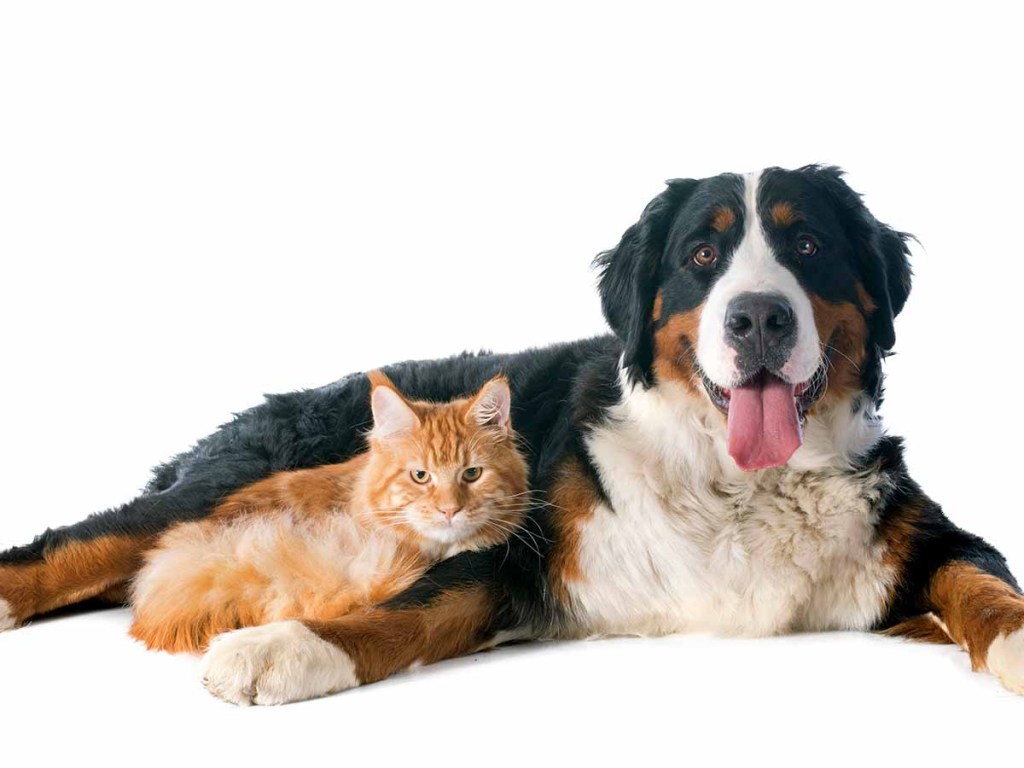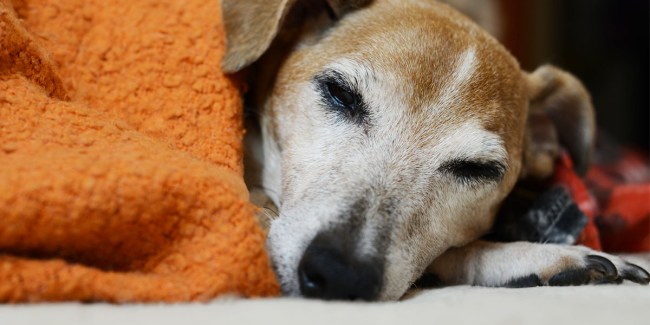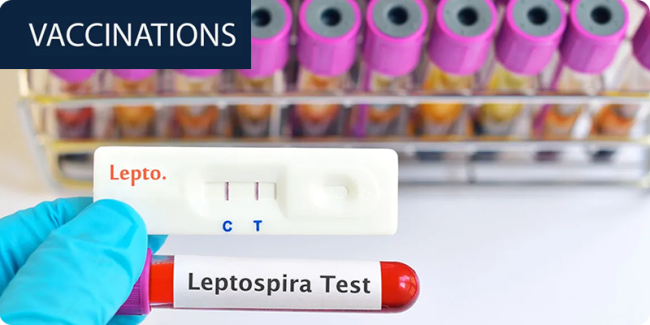
About diabetes mellitus
Successfully managing your diabetic pet’s health is possible with insulin therapy, the correct diet, and exercise
If your dog or cat has been diagnosed with diabetes mellitus, it’s easy to feel alone—but you’re not. It is estimated that 1 out of every 100 dogs that reach 12 years of age will develop diabetes.1 In cats, it’s estimated that between 0.2 percent and 1 percent of cats will be diagnosed with diabetes during their lifetime.7
Diabetes mellitus occurs when your dog or cat has stopped producing insulin, has inadequate levels of insulin, or has an abnormal response to insulin.
In dogs, diabetes mellitus is common in middle-aged to older animals, especially in females, but it is also seen in young dogs of both sexes. When seen in younger animals, it can be a sign that your dog is genetically predisposed to diabetes—this can mean that related animals may also be predisposed.3 Certain breeds of dogs also experience above-average rates of diabetes. These include4:
- Toy poodles
- Terriers
- Cocker spaniels
- Dachshunds
- Doberman pinschers
- German shepherds
- Labrador retrievers
- Golden retrievers
In cats, diabetes mellitus is more common in middle- to older-aged animals as well, and also in cats that are overweight. Also, neutered males are at a greater risk than females. Certain breeds, such as Siamese cats, experience an above-average rate of diabetes.
Some drugs, when used long-term, may interfere with insulin and lead to diabetes mellitus in your pet. These include glucocorticoids (cortisone-type drugs) and hormones that may be used to control heat cycles in female dogs.3
It is important to note the difference between diabetes mellitus and diabetes insipidus. Diabetes insipidus, also known as water diabetes, occurs when the kidneys are unable to regulate fluids in the body, and large amounts of dilute urine are produced. This condition is far less common than diabetes mellitus. Diabetes insipidus is caused by problems in part of the brain or in the kidneys, and there is no glucose (sugar) present in the urine of these animals. Diabetes insipidus is very rare in dogs and cats, and is only diagnosed after extensive testing of your pet’s blood and urine. Some common signs of diabetes insipidus include excessive thirst and drinking of water, increased urination, and dilute urine.5,6
Can your dog or cat be cured?
In general, diabetes cannot be cured. However, if you establish an appropriate lifestyle for your dog or cat, including good glycemic management with a diabetes product such as Vetsulin® (porcine insulin zinc suspension), your pet will likely be capable of leading a happy, healthy life.
Some cats have transient diabetes and can go into remission, but it is more likely that a cat will have diabetes for life.
Understanding insulin
During digestion, your dog’s or cat’s food is broken down into smaller components for use by the body. Carbohydrates are converted into various sugars, including glucose. Glucose is absorbed from the intestines into the blood and provides the body’s cells with energy. However, glucose can only enter most cells if the hormone known as insulin is present.
Insulin is normally produced by the beta cells of the pancreas and is required by the body to transport glucose (sugar) from the bloodstream into the cells of the body for energy.
In diabetic dogs and cats, these cells in the pancreas produce little or no insulin, or there is an abnormal response to the insulin that is produced. When this happens, glucose cannot enter into the body’s cells and therefore begins to accumulate in the blood. In addition, the cells of the body are starved for energy. This combined effect is known as diabetes mellitus. Simply put, diabetes results from a shortage of insulin.
Insulin fast facts
Insulin is a hormone that keeps your dog’s or cat’s glucose concentration at a normal level while delivering glucose (energy) to the body’s cells.
Insulin is produced by certain cells in the pancreas.
In diabetic animals, these cells produce little or no insulin, or there is an abnormal response to the insulin that is produced.
Signs of diabetes mellitus
If any of the following signs apply, you should bring your dog or cat to your veterinarian for a checkup.
- Urinates frequently – your dog or cat wants to go outside often. Your dog may urinate in the house; your cat may urinate outside of the litter box.
- Drinks a lot of water – you must fill the water bowl more often than before or notice your cat or dog drinking from unusual places, such as the toilet bowl.
- Is always hungry – never seems to get enough; always begging for food.
- Has lost weight
- Eyes appear cloudy (this sign is only present in dogs)
- Coat has deteriorated – your cat has stopped grooming, and her fur becomes dry and dull
- Sleeps more or is less active
Diagnosis
The above signs certainly suggest diabetes, but they are also seen in other diseases. The diagnosis only becomes definite when glucose is found both in the urine and at a high level in the blood. This is why your dog or cat needs to be examined thoroughly by a veterinarian.
To confirm the diagnosis, your veterinarian will take blood and urine samples from your pet and determine the glucose content or “sugar” in both. Your veterinarian will also check your pet’s general health status (to rule out the presence of other diseases or infections). This is very important, as infections, some diseases, and other medications can make the management of diabetes more difficult.
Management
Because diabetes is caused by a lack or shortage of insulin, your dog or cat may need management with insulin such as Vetsulin® (porcine insulin zinc suspension), an FDA-approved veterinary insulin. Diabetes can usually be controlled by simply learning to give your pet daily insulin injections to control the blood glucose level. If your pet has other problems as well, your veterinarian will suggest the appropriate management.
Your veterinarian will help you find your dog’s or cat’s correct dose. This process may take a few weeks, but the end result is very manageable. Once you have the correct insulin dose, it is extremely important that you administer your pet’s therapy at approximately the same time every day.
Just like any routine, getting used to this will take a little time. Once you and your pet acclimate, however, you’ll both find the process fairly simple, painless, and quick. Along with insulin therapy, your veterinarian will set up a management program that will include recommendations for feeding your dog or cat (type of food, quantity, and timing of meals). Your vet may discuss periodic monitoring of your pet’s fructosamine level, which can help determine if your pet’s diabetes is being successfully regulated. Diabetic pets also benefit from regular exercise—especially if they are overweight.
Possible complications of diabetes in dogs and cats
The long-term complications of diabetes mellitus are a result of prolonged high blood glucose (hyperglycemia). Obtaining optimal control of blood glucose helps to minimize these long-term complications.
IN DOGS, the most common diabetes-related complications include:
- Low blood sugar or hypoglycemia (that may be induced by incorrect insulin dosing)
- Ketoacidosis (ketones and high acidity in body fluids)
- Cataracts
IN CATS, the most common diabetes-related complications include:
- Low blood sugar or hypoglycemia (that may be induced by transient remission or incorrect insulin dosing)
- Chronic pancreatitis (inflammation of the pancreas)
- Poor grooming and dry, lusterless coat
- Recurrent infections
- Ketoacidosis (ketones and high acidity in body fluids)
- Peripheral neuropathy (nerve dysfunction resulting in an abnormal stance)
Diabetic ketoacidosis in dogs and cats
What causes diabetic ketoacidosis (DKA)?
DKA is a condition that develops when cells do not get the amount of glucose they need to produce energy, and the body attempts to supplement the lack of glucose by breaking down muscle and fat for energy. When this happens, ketones and fatty acids enter the bloodstream, causing the chemical imbalance known as DKA.
DKA develops due to:
- Long-standing, undiagnosed diabetes mellitus.
- Insufficient insulin dose in treated diabetics.
- Reduced insulin action—caused by obesity, concurrent illness, or drugs.
- Due to a lack of insulin, glucose cannot be used by the body cells as an energy source. Instead, fat is broken down to provide energy.
- When fat is used as an energy source, acids known as ketones are produced. Ketones circulating in the blood cause signs of DKA—decreased or no appetite, vomiting, and lethargy.
Diagnosis
The diagnosis of DKA is based on detecting ketones in the urine along with signs of illness. Read more about monitoring glucose and ketones in your dog’s or cat’s urine. Diabetic ketoacidosis is an emergency. Contact your veterinarian.
Management
Your veterinarian will administer intravenous fluids and short-acting insulin and correct any underlying disorders to stabilize your pet. Once your pet is stabilized, he or she will be started on long-term insulin therapy again.
Diabetic cataracts in dogs
This is one of the most common complications of diabetes in dogs. A cataract is when the lens of the eye becomes cloudy; blindness results in the affected eye or eyes.
What causes diabetic cataracts?
Excess glucose in the bloodstream causes changes in the lens of the eye. Water enters into the lens, causing swelling and changes in the lens structure. This results in the cloudiness that is seen.
Management
The lens of the eye can be removed surgically to restore vision. Control of high blood glucose levels may help delay the onset of diabetic cataracts.
Peripheral neuropathy in cats
Peripheral neuropathy, a disease or degeneration that affects the nerves, is one of the most common chronic complications of diabetes in cats. Often referred to as diabetic neuropathy, this disorder typically affects the hind legs, causing weakness, loss of coordination, inability to jump, and a distinct stance or posture in which the cat’s rear legs touch the ground when it walks.
Management
Though there is no specific therapy for diabetic neuropathy in cats, intensive blood glucose control decreases the risk and improves clinical signs in humans. Similarly, aggressive adjustment of insulin therapy may improve nerve function and reverse hind leg weakness and abnormal stance in diabetic cats. However, a cat’s response to this therapy varies and aggressive insulin management increases the risk of hypoglycemia.
Successfully managing your diabetic pet’s health is possible with insulin therapy, the correct diet, and exercise. With the successful control of diabetes mellitus, you can expect your pet to live a happy and normal life.
REFERENCES:
- Nelson RW. Canine diabetes mellitus. In Ettinger SJ, Feldman EC, eds. Textbook of Veterinary Internal Medicine. 7th ed. St. Louis, MO: Saunders; 2010:1782–1796.
- Reusch C. Feline diabetes mellitus. In Ettinger SJ, Feldman EC, eds. Textbook of Veterinary Internal Medicine. 7th ed. St. Louis, MO: Saunders; 2010:1796–1816.
- Pet Health Topics: Diabetes mellitus. Washington State University College of Veterinary Medicine. https://hospital.vetmed.wsu.edu/2022/03/17/diabetes-mellitus/
- Feldman EC, Nelson RW. Canine and Feline Endocrinology and Reproduction. 3rd ed. St. Louis, MO: Saunders; 2004:486–538.
- Diabetes insipidus in dogs. VCA Animal Hospitals. https://vcahospitals.com/know-your-pet/diabetes-insipidus-in-dogs
- Diabetes insipidus in dog. PetMD. https://www.petmd.com/dog/conditions/endocrine/c_dg_diabetes_insipidus
- Feline diabetes. Cornell Feline Health Center. https://www.vet.cornell.edu/departments-centers-and-institutes/cornell-feline-health-center/health-information/feline-health-topics/feline-diabetes
IMPORTANT SAFETY INFORMATION: VETSULIN® and VETPEN® are for use in animals only. Dogs and cats known to have an allergy to pork or pork products should not be treated with VETSULIN®. VETSULIN® is contraindicated during periods of hypoglycemia. Animals with severe ketoacidosis, anorexia, lethargy, and/or vomiting should be stabilized with short-acting insulin and appropriate supportive therapy before use. As with all insulin products, careful patient monitoring for hypoglycemia and hyperglycemia is essential. Overdosage can result in profound hypoglycemia and death. Progestogen and glucocorticoid use should be avoided. The safety and effectiveness of VETSULIN® in puppies, kittens, breeding, pregnant, and lactating dogs and cats has not been evaluated. Keep out of reach of children. Avoid contact with eyes. In case of contact, immediately flush eyes with copious amounts of water for at least 15 minutes. Accidental injection may cause clinical hypoglycemia. In case of accidental injection, seek medical attention immediately. Exposure to the product may induce a local or systemic allergic reaction in sensitized individuals. For complete safety information, refer to the product label.
More like this
- Caring for a senior pet
 Caring for a senior pet Cats and dogs may need … Read more
Caring for a senior pet Cats and dogs may need … Read more - Dealing with your pet’s allergies
 Dealing with your pet’s allergies Just like humans, pets can … Read more
Dealing with your pet’s allergies Just like humans, pets can … Read more - Five things you may not know about leptospriosis
 Five things you may not know about leptospirosis Leptospirosis is … Read more
Five things you may not know about leptospirosis Leptospirosis is … Read more




